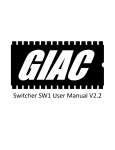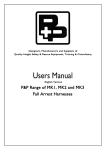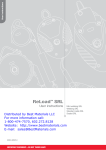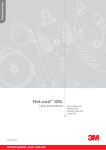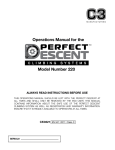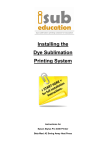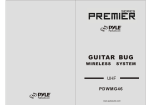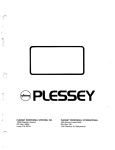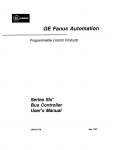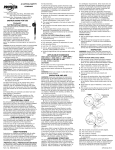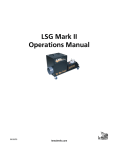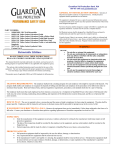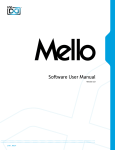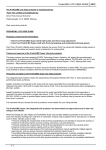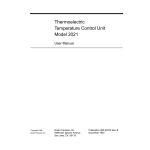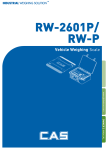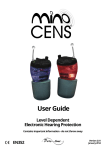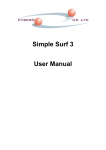Download User Manual
Transcript
Satra Technology Centre Kettering, Northamptonshire NN16 8SD United Kingdom OPERATOR’S MANUAL Doc No: MT01 Revision 4 Effective: 10TH OCTOBER 2012 M_TLineOperatorsManual_Final_160812.indd 1 16/10/2012 19:22 DESCRIPTION OF EQUIPMENT INTRODUCTION This Manual contains safety information and instructions for operating the T-Line system. This Manual should be stored in an area where it is accessible to operators of the T-Line system. Continued improvement and advancement of product design may have caused changes to your T-Line system, which are not included in this Manual. Some photographs or illustrations in this Manual may show details or attachments that are different from your T-Line system. Whenever a question arises regarding your T-Line, or this Manual, please consult the Meridian Safety Pty Ltd website at www.meridiansafety.com for the latest available information. Further information on operating the T-Line system is available in training material and courses. Further enquiry regarding these materials and courses should be directed to: [email protected] The Equipment Record and an Operators Manual must be supplied to the end user when the T-Line is sold, resold or otherwise made available for use. This is to ensure that the end user gets the necessary information for the safe use of the T-Line system. The T-Line is a twin lifeline system. The T-Line is a device containing twin lifelines on separate reels that rotate on a common shaft. The lifelines automatically pay out and retract during normal movement of the operator – and automatically lock at the onset of a fall. CUSTOMER SERVICE Please contact the authorized T-Line distributor in your area for enquiries regarding the operation, Periodic Examination and Recertification and Repair of your T-Line system. The distributor nearest you can be found by consulting www.meridiansafety.com IMPORTANT SAFETY INFORMATION • Do not use the T-Line unless you have read and understand the instructions and warnings in this Manual. Failure to follow the instructions or heed the warnings or improper operation could result in injury or death. • Do not tamper with or make any alterations to the T-Line. • The T-Line shall not be used outside its limitations as described in this Manual, or for any purpose other than that for which it is intended. • The operation and maintenance of the T-Line system must comply with the work safety laws of the jurisdiction in which it is used. Compliance may include the requirement for a Risk Assessment or Fall Hazard Survey Report. • Operators of the T-Line system must be properly trained and competent. • A full body harness suitable for fall-arrest is the only acceptable body holding device that can be used with the T-Line system. • Operators must carry out a Pre-Use Check of the equipment, as per the instructions in this Manual, to ensure that it is in a serviceable condition and operates correctly before it is used. • It is essential for safety that equipment is withdrawn from use immediately if the red indicator tab on the connector is exposed or should any doubt arise about its condition for safe use. • Do not remove the labels from the T-Line. Replace labels that are illegible. • For protection of one person only. • Operators should be fit and healthy – otherwise consult a physician before using the T-Line. Do not use if pregnant. • A rescue plan shall be in place to deal with any emergencies that could arise during the work M_TLineOperatorsManual_Final_160812.indd 2-3 The T-Line is designed to provide a safe means of accessing and working at height. • The operator can move freely along horizontal walkways or platforms. When the user is moving horizontally, one lifeline pays out whilst the other retracts - and the T-Line will not lock. • If the user falls, the T-Line will arrest the fall and hold the user. If the user falls, both lifelines pay out quickly - and the T-Line locks. The pulley brake grips the locked lifeline and prevents sliding. • The user can safely climb and descend. When climbing, both lifelines retract – and the T-Line will not lock. When descending under normal conditions, both lifelines pay out slowly – and the T-Line will not lock. • The T-Line has an integrated rescue function. The hand operated winch can be used to bring the suspended person back to the T-Line Unit. T-Line Anchor Eye Pulley Anchor Eye Main Lifeline Pulley Lifeline Pulley Lifeline Connector Connector Ring Pulley Pulley Stowage Pocket Main Lifeline Connector - swivel connector with fall indicator Rescue Handle Ancillary Anchor Eye for Stabiliser Sling Serial Number (opposite face) IMPORTANT: The Pulley Lifeline Connector (5) must be properly secured to the Connector Ring (6) when using the T-Line in twin line mode. When using the T-Line in single line mode, the Pulley Lifeline Connector (5) must either be connected to the Ancillary Anchor Eye (11) or a certified fall arrest anchor point rated to at least 15kN (3400 lbs). Failure to do so could result in serious injury or death. Always ensure that an alternate means of fall protection is utilized whilst changing between modes. 16/10/2012 19:22 INSTALLATION 1 MAKING PROPER CONNECTIONS 2 The T-Line must be attached with a suitable anchor system to a structure with a minimum strength of 22kN / 5,000lb The pulley must be attached with a suitable anchor system to a structure with a minimum strength of 22kN / 5,000lb The Pulley is taken from the Pulley Stowage Pocket and moved to the far end of the elevated work area – extracting the Pulley Lifeline along the way. The Pulley Lifeline loops around the Pulley before being attached to the Connector Ring using the Pulley Lifeline Connector. The T-Line and Pulley must be installed overhead The Pulley must not be mounted below the T-Line Do not allow slack in anchor slings as this will increase arrest distance. Installation of a 24m T-Line unit must be carried out by an Authorised T-Line Installer Anchorage Minimum Strength 22kn / 5,000lb SAFE WORKING AT HEIGHTS DURING INSTALLATION Ensure that the risk of fall from height is controlled during installation. For example, a mobile elevated work platform may be used during installation. 1 The Pulley Lifeline must be attached to the Connector Ring using the Pulley Lifeline Connector. 2 The Main Lifeline is terminated with a swivel connector – carabineer or snaphook – with fall indicator. 3 The operator attaches to the Main Lifeline to the dorsal attachment point of their full body, fall arrest harness. ANCHOR POINT SPECIFCIATION AND CONNECTION The anchorage and structure to which the T-Line is attached shall be capable of sustaining a static load of 22.2kN / 5,000lb. Assess the building or structure and verify the adequacy of the anchor point before the system is put in to service. A suitable connector and anchor system must be used to connect the T-Line to the supporting structure. For example: the T-Line Clevis Anchor Point, the T-Line Beam Clamp or the T-Line Anchor Sling (each sold separately). Do not allow slack in anchor slings as this will increase arrest distance. All components and subsystems should also comply with applicable Standards. Follow manufacturer’s instructions. Unless specifically allowed by the manufacturer, slings should not be choked and lanyards should not be back-hooked. Connectors should be compatible in size and shape to prevent rollout. M_TLineOperatorsManual_Final_160812.indd 4-5 16/10/2012 19:22 GENERAL PRE-USE CHECK Do not pass the lifeline(s) over sharp or abrasive edges. Do not allow lifelines to come into contact with live electrical sources Do not allow the lifeline(s) to deflect around plant and equipment or other obstacles. Do not allow chemical reagents to contact the lifelines, casing or internal mechanism Do not cross over with other lifelines. Do not allow the lifeline(s) to pass under head, arms or legs or wrap around the body. Do not hold or lock off the lifeline(s). Do not let the lifeline(s) retract uncontrolled. Do not allow foreign material to enter casing. Avoid using the T-Line in hazardous environments such as extremes of temperature or highly corrosive atmospheres. Pre-Use Checks are essential and should be carried out by the operator each time, before the T-Line system is used. SAFE ACCESS AND CONTINUOUS PROTECTION Ensure that users can approach and connect to the T-Line without being exposed to a risk of fall. For example: the Main Lifeline Connector or a tag to the Main Lifeline Connector should be left in a suitable location so that users may connect to the system before moving to where there is a risk of fall. The same applies to egress and disconnecting. If the Pre Use Check finds any defect or should any doubt arise about its condition for safe use it is essential for safety that equipment is not used and withdrawn from use immediately. Check the Equipment Record to ensure that that the Periodic Examination and Recertification is up to date. The Pre-Use Check of the T-Line consists of visual checks and checks of operation. • Visually inspect the T-Line casing and lifelines for signs of damage or cracking that may reduce the structural integrity of the device in any way. • Withdraw approximately 1m of each lifeline and check that it remains under tension and then rewinds smoothly • Withdraw the Main Lifeline rapidly to check that it locks • Inspect the swivel connector with fall indicator. If any portion of the indicator reveals the red marker, the T-Line should be removed from service. Check the fall-arrest harness, other connectors and anchor slings (if used) as per the manufacturer’s instructions. Ensure continuous connection to the T-Line whenever there is a risk of fall from height; or if not connected and there is a risk of fall from height, then an alternate means of fall protection must be employed. TRANSPORT RESCUE Ensure that the T-Line is fully retracted with the Pulley stowed in the Pulley Stowage Pocket in preparation for transport. Ensure that the T-Line is protected from excessive vibration or impact during transport. 1 2 PERIODIC EXAMINATION AND RECERTIFICATION The continued efficiency and durability of the T-Line system and the safety of the user depends on regular Periodic Examination and Recertification. Periodic Examination and Recertification is additional to the Pre Use Check and is a more formal, indepth inspection and must be carried out at intervals of 12 months or less. Under extremely severe corrosive liquid or abrasive dust exposures or for operation under extremes of temperature, more frequent Periodic Examination and Recertification may be necessary. Release the Rescue Handle by removing the retaining pin. Fold the handle down and align the slot in the handle with the shaft in the centre of the winch boss. Ensure that the handle is pushed fully into the winch boss. Once engaged, the handle will be retained by the sprung loaded steel ball. M_TLineOperatorsManual_Final_160812.indd 6-7 Rotate the Rescue Handle in the clockwise direction to transport the suspended user towards the T-Line unit. Maintain constant visual contact with the user. Do not harm the rescue subject. Stop winching if the rescue subject is caught or snagged. Periodic Examination and Recertification is only to be conducted by an Authorized Service Agent. WITHDRAWAL FROM USE AND REPAIR It is essential for safety that equipment is withdrawn from use immediately should any doubt arise about its condition for safe use. Repairs are only to be conducted by an Authorized Repair Agent. 16/10/2012 19:22 EQUIPMENT RECORD LABELS Documentation is a key element of a well-managed personal protective equipment program. Equipment Records should be maintained as proof of Periodic Examination and Recertification and Repair. It is the responsibility of the user organization to enter onto the Equipment Record the details required. Shows the correct orientation of the T-Line once installed Engraving a “1”, “2” or “3” in this table shows the month and year of last service and type of service performed ie Level 1, 2 or 3. CLEANING AND STORAGE Use a damp (not wet) cloth to remove dirt or other contaminants from the casing. Do not use abrasives or solvents. Mild detergent may be used but residue must be wiped away. Use a bristle brush to remove dirt or other contaminants from the lifelines. Do not use a wire brush. Do not use gasoline or solvent. Lubrication may be applied to a clean dry lifeline with a cloth. Never immerse in water. If water does get into the casing, hang the unit and slowly withdraw each lifeline allowing the water to run out. Use a clean dry cloth to wipe the lifeline dry as it returns. Repeat if required. Maximum Span that the T-Line may be used upon Store the T-Line in a clean, dry place. EQUIPMENT RECORD Serial Number: Owner: Date of Manufacture: Name of Organisation: Date of Purchase: Address: Remove Pin Date first put into use: Fold Handle Down DateActivity Remarks Name & signature of Competent Person Next service due POSES ION PUR ORD - T REC UIPMEN EQ M_TLineOperatorsManual_Final_160812.indd 8-9 STRAT U L L I R FO ONLY Rotate Handle in clockwise direction Image showing how to make proper connections 16/10/2012 19:22 12m /40’ SAFE LIMIT OF OPERATION T-LINE SAFETY SYSTEM MODEL T01 FREE FALL The operator must remain below the T-Line and the Pulley. When the operator is within the vertical Safe Limit of Operation, the Lifelines will exhibit retraction tension and the connector ring will be above the operator’s head. Never work at a level where the operators head is above the connector ring. (Note: It is normal for the Lifelines to exhibit some catenary or sag, particularly at wider spans.) PENDULAR SWINGS The operator must remain between the T-Line and the Pulley. Minimize pendular swings by working directly below the Pulley Lifeline which runs between the T-Line and the pulley. FALL CLEARANCE It is essential that there is adequate clearance under the system so that in the event of a fall the operator will not strike the ground or any obstacle. SPECIFICATION MODEL T01 The 12m / 40’ T-Line can be installed at a maximum span of 12m / 40’. At this span, the maximum vertical reach is 6m / 20’. HEIGHT The T-Line can be installed for a maximum vertical reach of 12m / 40’. At this vertical reach, the maximum span is 6m / 20’. The T-Line can be installed at spans and vertical reach between the limits as set out above. MAXIMUM SPAN MAXIMUM VERTICAL RANGE MAXIMUM FALL ARREST DISTANCE MAXIMUM FALL ARREST FORCE ANCHORAGE RATING REQUIREMENT WIRE ROPE MIN BREAKING FORCE (5mm diameter, 7x19 Strand) WEIGHT 12m / @ 12m / 40’ span 6m / @ 6m / 20’ span 12m / 1.8m / 6kN / 22kN / 17kN / 22.5kg / 40’ 20’ 40’ 6’ 1,350lb 5,000lb 3,820lb 50lb HEIGHT / 2 If you have any questions about how to configure and use your T-Line safely, then contact Meridian Safety at [email protected] M_TLineOperatorsManual_Final_160812.indd 10-11 SINGLE LINE MODE 16/10/2012 19:22 24m /80’ XL T-LINE SAFETY SYSTEM MODEL T01L The 24m / 80’ T-Line can be installed at a maximum span of 24m / 80’. At this span, the maximum vertical reach is 20m / 65’. For spans greater than 20m/65’ and up to 24m/80’, the 24m/80’ T-Line can provide a vertical range of 20m/65’. For spans of 18m/60’ or less, this T-Line can provide a vertical range equal to that of the span. The T-Line can be installed at spans and vertical reach between the limits as set out on this page SAFE LIMIT OF OPERATION The installation of the 24m T-Line must be carried out by an authorised T-Line Installer. FREE FALL The operator must remain below the T-Line and the Pulley. When the operator is within the vertical Safe Limit of Operation, the Lifelines will exhibit retraction tension and the connector ring will be above the operator’s head. Never work at a level where the operators head is above the connector ring. (Note: It is normal for the Lifelines to exhibit some catenary or sag, particularly at wider spans.) PENDULAR SWINGS The operator must remain between the T-Line and the Pulley. Minimize pendular swings by working directly below the Pulley Lifeline which runs between the T-Line and the pulley. Produce a safe limit of operation description for both the 12m and 24m T-Line when being used in V-Line configuration. FALL CLEARANCE HEIGHT If you have any questions about how to configure and use your T-Line safely, then contact Meridian Safety at [email protected] It is essential that there is adequate clearance under the system so that in the event of a fall the operator will not strike the ground or any obstacle. HEIGHT Produce a safe limit of operation diagram and description for single line mode. HEIGHT / 2 *Spans of less than 14m may require shortening of lifelines. M_TLineOperatorsManual_Final_160812.indd 12-13 SINGLE LINE MODE SPECIFICATION MODEL T01L MAXIMUM SPAN 24m / HEIGHT / 2 MAXIMUM VERTICAL RANGE @ 24m / 80’ span 20m / @ 18m / 60’ span 18m / @ 12m / 40’ span 12m / MAXIMUM FALL ARREST DISTANCE 1.8m / MAXIMUM FALL ARREST FORCE 6kN / ANCHORAGE RATING REQUIREMENT 22kN / WIRE ROPE MIN BREAKING FORCE 17kN / (5mm diameter, 7x19 Strand) WEIGHT 22.5kg / 80’ 65’ 60’ 40’ 6’ 1,350lb 5,000lb 3,820lb 50lb 16/10/2012 19:22 WARRANTY CORRECT / INCORRECT USE SINGLE LINE MODE TWIN LINE MODE MAX 24M (80’) MAX 24M (80’) Meridian Safety Pty Ltd warrants to the owner-user that Meridian Safety’s DETAIL VIEW T-Line product will be free from defects in material and workmanship. This warranty for new products is limited to two years from the date of purchase. DETAIL VIEW Meridian Safety Pty Ltd’s obligations under this warranty are limited to the replacement of the equipment or repair of the equipment. Meridian Safety Pty Ltd shall not be liable to the customer for any incidental, consequential, exemplary, special or punitive damages, nor for any loss of revenue, profit or use arising out of a breach of this warranty or in connection with the sale, maintenance, use, operation or repair of the product. In no event will Meridian Safety Pty Ltd be Sloping Roofs / Anchor Points at different Heights liable for any amount greater than the purchase price of the defective product. This warranty, during the original warranty period, extends beyond the original purchaser to subsequent owners of the T-Line. Repairs carried out under warranty do not extend the warranty period. The warranty provided herein shall be void and of no effect in the event that WARNING INCORRECT USE OF THE T-LINE CAN EXPOSE THE USER TO RISK OF SERIOUS INJURY OR DEATH a) the product has been operated outside its designed use; b) the product has been subjected to misuse, neglect, accident, improper or inadequate maintenance; c) unauthorized modification(s) have been made to the product; d) the product has not been installed and operated in compliance with Meridian Safety Pty Ltd’s instructions, e) the serial number of the product has been altered, defaced or removed. M_TLineOperatorsManual_Final_160812.indd 14-15 16/10/2012 19:22 TUV NEL East Kilbride, Glasgow G75 0QF United Kingdom t-linesafetysystem.com M_TLineOperatorsManual_Final_160812.indd 16 16/10/2012 19:22









